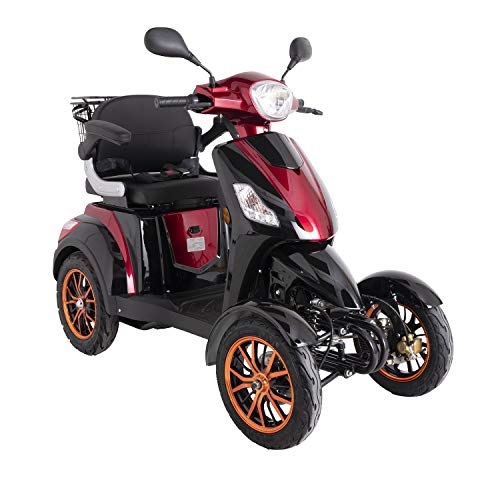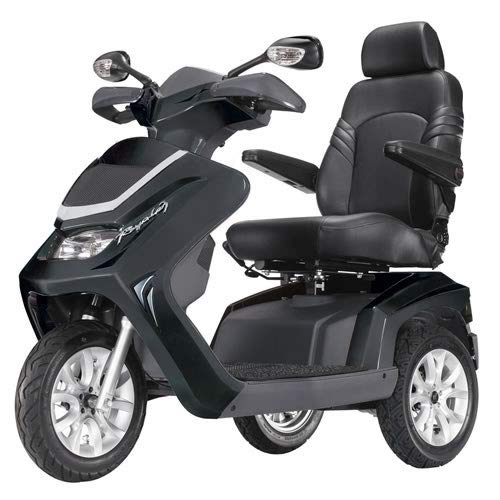20 Insightful Quotes On Electric Micro-Mobility
페이지 정보

본문
 NYCHA and EV Micro-Mobility
NYCHA and EV Micro-Mobility EV micro-mobility is a cost-effective solution to fill the first-and last-mile gap and complements public transport. NYCHA recognizes that e-bikes and escooters are vital to low-income residents and can provide opportunities to exercise, particularly when shared.
EV micro-mobility is a cost-effective solution to fill the first-and last-mile gap and complements public transport. NYCHA recognizes that e-bikes and escooters are vital to low-income residents and can provide opportunities to exercise, particularly when shared.However, they also come with particular challenges. They must be monitored, tracked and managed.
Accessibility
Electric micro-mobility has emerged as an ever-growing segment of the transportation industry. It offers service providers and technology opportunities to transform urban mobility paradigms, and reduce congestion. The rapid growth of this sector also poses challenges for the sector. These include data collection as well as safe battery installation and establishing charging infrastructure. These challenges need to be addressed in order to ensure that electric micromobility is accessible for all, including those with disabilities.
Electric-powered bikes, scooters and other lightweight, small devices allow users to go further, faster, and in more comfort than with traditional scooters and bikes. They can be used in city streets as well as on sidewalks, bike trails and even on trails. They are typically powered by lithium-ion batteries and have the capacity to travel up to 20 miles on a charge. They can be bought for personal use, or rented through a sharing system.
In cities across the world, a growing number of innovative ebikes and escooter systems are being integrated into their shared mobility networks. They have helped reduce their carbon footprint and increase their efficiency. They also offer new transportation options for those who otherwise have to rely on transportation via cars. The availability of these vehicles has increased access to mobility services and made it easier for communities to withstand situations like weather-related disruptions and oil shortages.
In the United States, the e-bike market has seen a rapid growth in recent years, fueled by technological advancements and a growing consumer demand. The market is dominated by a handful of major companies, such as Segway, Yunxi and Ninebot. These companies produce high-quality, affordable products. These companies are striving to expand their market share by implementing aggressive marketing strategies and partnerships with bicycle makers.
While e-bikes, escooters electric mopeds, electric scooters and other small-sized mobility devices consume a small amount of electricity, their growing popularity will increase the demand for energy on the grid. This will require significant investments in infrastructure and charging stations. Utilities can prepare for increasing demand by leveraging smart grid technology to analyze consumer charging behaviors, introduce demand-response plans, and provide incentive-based rate plans for EV charging.
Despite their promises to improve equality in the economy and social equity however, the fire risks of e-micromobility are a serious concern. Additionally, the increasing use of e-micromobility systems in public housing will result in a need for stricter rules to protect residents' safety. NYCHA's policy on e-micromobility is designed to prevent fires and other injuries, while giving residents a convenient, affordable transit alternative.
Energy efficiency
Electric micro-mobility is more environmentally friendly and uses less energy. Its battery uses renewable sources, which means that it emits zero carbon dioxide. This is a huge benefit for cities striving to achieve carbon neutrality and reduce air pollution. Additionally, they require less space to park and are quieter than cars.
Whether it's an e-scooter, an e-bike, or a monowheel, these new vehicles are transforming the way people move in urban areas. Their increasing popularity has prompted cities to study their impact on sustainable transportation. indoor electric mobility scooter micro-mobility, dependent on the model and the power source, can cut down on traffic congestion, improve quality of air, and save fuel. However the new vehicles could also pose a challenge to existing infrastructures and laws.
The most popular micromobility device are e-scooters, which are compact and electrically powered scooters that are rental via smartphone apps. These scooters are capable traveling at speeds that exceed 30 km/h and can be used on bike paths, or streets. Other options for micromobility include the rickshaws and ebikes.
These new modes of transportation are gaining in popularity and the share of modalities of EMM will increase by 5-10% by 2030. However, researchers need to better understand the determinants of EMM use, which includes both contextual and individual factors. This review focuses on the current state of knowledge regarding determinants of EMM use and identifies future research priorities.
There are currently many obstacles to the widespread use of electric micro-mobility. One of the issues is the absence of adequate charging infrastructure for e-scooters, as well as other devices. Another concern is safety. If these issues aren't addressed, then the advantages of this method of transportation could be diminished.
Many cities are struggling to find ways to accommodate these vehicles without compromising the integrity or security of existing bridges or roads. One option is to construct dedicated lanes for these vehicles. In this case the driver of the vehicle will be required to adhere to strict traffic rules and adhere to speed limits. The device also needs to be equipped with specialized technology in order to perform as it should. In addition the batteries have to be designed to comply with international standards and are subject to frequent replacements.
Environmental impact
electric folding mobility scooter uk, super fast reply, micro-mobility has a number of environmental benefits including less energy consumption and emission. However, these devices require electricity to operate, so their use could increase peak demand. Utilities can reduce the impact of this by analyzing consumers' charging behavior and introducing demand-response programs. They can also introduce net-metering for electricity consumption at the retail level and incentive-based rate plans for charging EVs. The growing popularity of ebikes and escooter services also provides new business models and investment opportunities for utilities.
The life cycle assessment is an essential factor when evaluating the environmental impact shared electric mobility scooters uk micro-mobility. LCA offers a thorough evaluation of the environmental burden of shared electric mobility scooters for sale near me micro-mobility services, by taking into consideration a variety of factors, including raw-material extraction, manufacturing, energy consumption, and the management of the end-of-life. The majority of studies utilized the cumulative energy demand method to measure the energy consumption of the primary source, while others employed other impact assessment methods like ReCiPe or IPCC.
The sensitivity of GWP estimates from the life-cycle assessment of EMM is dependent on the lifespan of the vehicle as well as the battery manufacturer and material, and the power source mix for charging. The sensitiveness of the rebalancing process is also crucial with nearly half of the review studies examining scenarios for rebalancing to assess its impact on GWP estimates. Many of the scenarios for rebalancing show small impacts, particularly when the vehicles are retrieved by low carbon servicing vehicles, such as E-cargo bikes and e-vans or when the distances for servicing are reduced.
While a wide variety of micromobility vehicles have been developed however, there are still a few obstacles for the sector to grow. There are a number of barriers to the growth of this industry, including the absence of policies that encourage shared micromobility, as well as concerns about the safety and reliability e-bikes. In spite of the rapid growth of the market, a number of public and private organizations are trying to address these issues. Some of these initiatives include the creation of shared bike and scooter systems that allow those who might not be able to ride traditional bicycles or scooters. Other initiatives include the development of mobility-as-a-service platforms, which consolidate a variety of transportation options into one convenient service.
Safety
Micro-mobility has seen a huge rise in popularity in the past few years. However, there is still plenty of work to do. While the latest technology has numerous benefits but it also raises many safety issues. Some of the most common risks associated with micromobility are batteries that explode, accidents, and crashes. These risks can be mitigated through a variety of best practices. To reduce the chance of these incidents, NYCHA has established a set of guidelines that ensure the safety of e-micromobility devices in its communities. Additionally, NYCHA has established a set of best folding electric mobility scooter for adults uk methods for charging the batteries of these devices. This reduces the chance of an accidental fire, which is especially dangerous for seniors and children.
The most significant safety issue that is associated with electric micro-mobility is the possibility for battery fires. These devices are powered by lithium-ion battery packs, which could cause serious injuries or even death if they catch on fire. Lithium-ion batteries are extremely flammable and produce toxic gases, making them difficult to put out. To prevent this from happening you must follow the recommended charging methods and purchase top-quality batteries from reliable brands. In addition, it is important to purchase a device that has been UL (Underwriters Laboratories) tested and certified.
Another security concern is that administrative and regulatory structures have only just begun to monitor and recognize the e-scooter and ebike-related accidents. Police incident reports and hospital emergency rooms have only begun collecting searchable data on e-scooter- and ebike-related injuries by 2023. This leaves a gaping hole in the legal and safety information.
Fortunately, many organizations are tackling these challenges by creating an environment that provides an equitable and safe method of mobility for all residents. They are organizing cross-departmental coordination groups and developing pilot studies to investigate innovative ways to encourage micromobility. These efforts include community engagement, e-scooter ambassador programs, and training for riders. They are also examining the possibility of introducing new funding sources as well as establishing procedures for reporting injuries.
The introduction of 4 wheeled electric mobility scooter 1000w veleco faster micromobility has reshaped traditional models of transportation. It is an excellent method to increase mobility and accessibility for people with disabilities. These vehicles offer an efficient alternative to walking or using a wheelchair and can help bridge first and last mile gaps. These vehicles are also an excellent alternative for seniors who are unable to walk or drive for long distances.
- 이전글Which Website To Research Best Robot Cleaner Online 25.04.11
- 다음글10 Things That Your Family Teach You About 8ft Shipping Containers 25.04.11
댓글목록
등록된 댓글이 없습니다.
